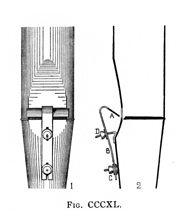

|
Viola d'Amore Italian Viola d'Amour (unknown) Viole d'Amour French |
Viol d'Amore (unknown) Viol d'Amour (unknown) Liebesgeige German |
A small-scaled soft-toned string stop of 8' or 4' pitch, voiced to resemble to some degree the tones of the stringed instrument of the same name. Audsley calls it the softest and sweetest of the imitative string stops; others have called its tone “refined”. Its open metal pipes are usually cylindrical with harmonic bridges. According to Audsley, they are sometimes conical, and sometimes with a slotted bell, and the 8' and 4' octaves may be straight or pyramidal wood. Skinner describes them as conical, with a reedy tone, but Irwin claims they are sometimes slightly inverted conical. Wedgwood's entire description reads: “practically identical with Echo Gamba, but sometimes a slightly sharp-toned Dulciana.” Maclean considers it practically identical with the Salicional. Audsley provides the illustration reproduced here (which Irwin copied without credit) which shows a tenor C pipe made by Henri Zimmermann for Audsley's own chamber organ. Williams dates Viol d'Amour (which we assume to be a synonym) from 1737 at Friedrichsstadt, Germany.
Other stops which claim to be the softest are Dolcissimo, Echo Dulciana Celeste, Echo Gamba, Fernflöte, Vox Angelica, and Vox Mystica.
The following examples are the oldest ones listed in Osiris.
Viola d'Amore 4', Canto; Nostra Signora della Consolazione Genova, Italy; Locatelli 1880.
Viola d'Amore 8', Manual IV; Dom, Schwerin, Germany; Ladegast 1871.
Viola d'Amore 8', Manual III; Johanniskirche, Wernigerode, Germany; Ladegast 1885.
Viola d'Amour 8', Choir; Congregational Church, Great Barrington, Massachusetts, USA; Roosevelt 1883.
Viola d'Amour 8', Oberwerk; Cathedral, Riga, Latvia; Walcker 1883.
Viole d'Amour 4', Recit; Parr Hall, Warrington, England; Cavaillé-Coll 1875.
Viole d'AMour 4', Recit; Saint Ouen, Rouen, France; Cavaillé-Coll 1890.
Liebesgeige 8', Oberwerk; Dreifaltigkeitskirche, Liepaja/Libau, Latvia; Grüneberg 1885.
Liebesgeige 4', Zungenschwellwerk; St. Michaelis, Hamburg, Germany; Walcker 1912 (destroyed).
|
Copyright © 2001 Edward L. Stauff, all rights reserved. ViolaDAmore.html - Last updated 27 May 2002. |
Home Full Index |